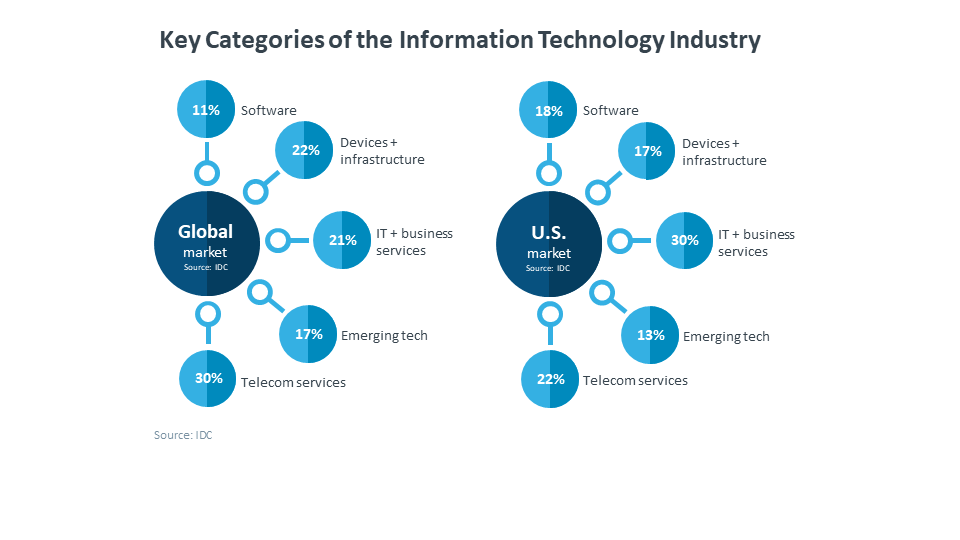5 Strategies to Improve the Effectiveness of Your IT Management

IT is pervasive in today’s setting. Businesses, governments, and individuals use IT products constantly for different purposes. In fact, it is forecast that the global spend would reach $5 trillion by the end of 2019. Most of the money streaming into the IT industry comes for corporations and government agencies. Households are also contributing to it, including home-based commercial ventures.
In the US, IT and business services take up 30% of the market, followed by telecom services (22%), software (18%), devices and infrastructure (17%), and emerging technologies (13%), according to a report by CompTIA. The sizable portion of the first item shows that businesses are concerned about transforming their operations using IT. This is where IT management comes in.

CompTIA reports that IT and business services are the greatest fractions that makes up the U.S. IT market.
As organizations invest in more tools, there is a growing need to manage those. Yet IT management is unique from the usual management and requires special skills and systems. To handle that, leaders and those in key positions need to put in place strategies that can help them succeed in this enterprise. Here are some of them:
1. Invest in reliable tools
IT management, like other types of management, is often done manually. Sure, there may be tools but they may not all be updated to the current standard. For any organization’s IT to have better administration, investing in reliable tools is a must. After all, the rest of the company look to them for technological know-how. With such tools, they can better assist end-users as well as take care of the back-end processes.
An IT management software is one of the examples of system management tools. It enables managers to manage and control IT resources and activities from anywhere to ensure that every cog in the machine is in tip-top shape. It can be a general platform or it can be specific to a process such as software lifecycle management.
Whatever the case is, features of system management can cover different bases. As a result, IT teams with limited budgets can perform a wide variety of tasks from a single platform.
2. Embrace the cloud
The cloud is everywhere today–most of the software that companies use to handle different processes are now deployed in it. This means they no longer have to worry about routine hardware or software maintenance. That is because vendors take care of those. All businesses have to do is maintain the configurations of their platforms.
Meanwhile, IT employees can focus on doing their jobs such as deploying enterprise application updates. This also translates to reduced operational costs and greater efficiency for the IT team.
Additionally, a cloud-based IT management system enables team members to work anywhere. This is beneficial for a manager who is always on the move. This way, they can oversee the department’s activities even if they are out of the office.
This setup can help enhance a team’s productivity as well. This is possible since they no longer have to worry about routine maintenance tasks, as they can offload those to the vendor.
3. Set up an IT self-service portal
One of the difficulties an IT department can face is the resolution of various technological problems. These can either be faced by other employees in the organization or by customers. This is where a huge role of information technology in management comes in: keeping customers loyal.
Ensuring that your paying audience continues to patronize your business has multiple facets. Satisfying them with a great customer service is one. However, if your IT team suffers from a deluge of requests, it can be difficult to achieve.
As such, it is a good idea to set up a self-service portal, a knowledge base where customers can look for answers to their queries. It can also contain self-help functions that enable them to troubleshoot issues by themselves for quicker resolutions.
4. Connect IT resources
An advantage of being in the cloud is seamless integration. As mentioned previously, many applications called SaaS are offered in the cloud. These have APIs and other connectors that enable IT teams to interface with other platforms. This is particularly advantageous for managing numerous enterprise solutions.
What’s more, a connected environment paves the way for the faster relay of information, such as website performance KPIs. This functionality can come in handy when members of the IT department need to troubleshoot problems regarding systems or platforms.
5. Standardize technology
IT architecture is based on the department’s direction and on the business’s requirements. To that end, it is necessary for the technology used by the IT team to be standardized. This way, things are simplified from cost to control.
Dummies.com shares in an article that among the targets for standardization in an IT department are:
- User workstation environments
- Software development
- Database management systems
By standardizing the components of these targets, a company can see huge savings and greater efficiency.
Training for change
While IT tools are designed for intuitiveness, there are still systems that require a certain amount of familiarity. Unless that is met, it would be difficult for IT to operate smoothly. That is why training is critical. This enables team members to know the ins and outs of the systems they will be using to better adopt it. With this, they can maximize the organization’s investment. Thereon, they can help affect the change the company wants to see.

